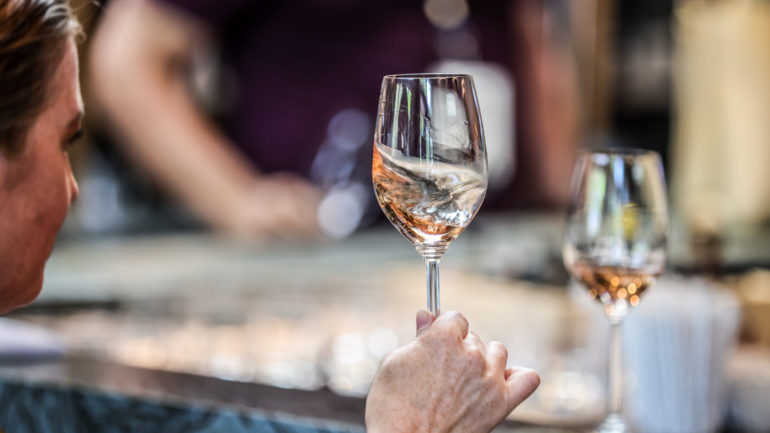
AN EXPERT GUIDE TO WINE TASTING
You might be wondering what wine tasting is all about if you’re new to the world of wine. Regular customers, wine connoisseurs, and industry professionals favor this way of judging wine quality. Whether you consider yourself an expert, aspiring wine enthusiast, or novice, learning how to taste wine correctly is one of the greatest ways to appreciate it. Therefore, wine tasting should be a fun and engaging experience rather than scary or full of “rules”! To better comprehend what’s in your glass and completely appreciate the subtleties that make wine so delightful to drink, consult our helpful guide to wine tasting.
WHY TRY WINE TASTING, AND WHO TASTES WINE?
You’ve probably observed that wines differ significantly from one another. There can be significant variance even within a single wine varietal, like Chardonnay. For instance, one wine can taste rich and oaky while another might taste fruity and light. These variations give wines their distinctive identities and are the basis for wine tasting.
A wine tasting is open to everyone. While some specialists taste wines to write reviews, purchase wine for a bar or restaurant, or rate certain vintages, average individuals can also partake in this enjoyable sensory experience. Many vineyards provide tasting tours allowing guests to sample their most popular selections. Parties with wine tastings have also gained popularity in recent years.
WINE TASTING TIPS FOR BEGINNERS
When taking part in a wine tasting, it can be helpful to understand the etiquette and terminology involved.
- Fill your glass with a meager amount of wine. Take just enough for one or two drinks and give the remainder to others.
- With each wine, take your time. Try to describe the aroma as you examine it in the glass. When you taste it, hold off on swallowing. Please keep it in your mouth for a short while to acquire a sense of its individuality.
- You might think about spitting out the wine if there is a spittoon. It is appropriate to conduct a wine tasting since it enables you to sample a variety of wines without being concerned that drinking would impair your judgment.
- Once you’ve tasted a wine, it’s acceptable to covertly dump the remaining wine into the spittoon if you don’t like it.
A STEP-BY-STEP GUIDE TO WINE TASTING FOR BEGINNERS
The look: Tilt the glass just a bit while holding it in front of your face. It will allow you to examine both the rim’s and core’s colors. To achieve a clear, objective view, try to perform it in front of a white background if at all possible. You should check the wine for clarity (cloudiness or haziness can either be an unfiltered or sour wine) and color intensity.
The scent, or “nose,” of wine: A thorough swirl is necessary to appreciate its aromatic range fully. The wine will interact with oxygen more when it is allowed to dance in the glass, releasing aromatic molecules and improving the tasting experience. The scents should travel directly up the nostrils after striking this edge. Inhale deeply to smell. Note any smells you are accustomed to. Repeat, but give your nose a few seconds to rest before taking a breath. It would help if you did this to get a sense of the wine’s initial smells.
The taste or “palate”: You could be thinking, “At last!” But before you get too enthusiastic, this part of the procedure also requires some techniques to be used. To begin with, take a deep breath before taking your first sip. It will aerate the wine once again and let out more smells. The wine must then be “chewed” next. Sure, chew. Simply swishing the wine around your mouth as you would mouthwash can help coat your entire mouth. The latter shows the amount of sweetness, alcohol, acidity, and tannin. The former will be anything like blackberry, chocolate, or lemon.
- Sweetness: This one should go without saying, but keep in mind that a dry wine is not the opposite of sweet wine.
- Alcohol: This term explains the burning sensation you experience at the back of your throat after consuming wine. Alcoholic beverages increase heat.
- Acidity: A wine’s acidity will determine its sharpness, freshness, and overall backbone.
- Tannin: A wine with a lot of tannins can make your mouth pucker and dry out.
Final step: This is, in fact, the last stage of the wine tasting procedure. Once the wine has left your mouth—after one previous sip, spitting, or swallowing—see how long you can still detect the fragrances (not tastes!).
CONCLUSION
Wine tasting is a talent that requires practice to master. You will get better at this entire sensory process the more wines you taste. It’s useful to understand the history of wine tasting, whether you’re participating in a tasting at a winery or shop, ordering a bottle in a restaurant, or hosting your own event. There are no rights or wrong answers when it comes to evaluating wines, which is one of the best things about tasting. Personal preference is the main factor in the procedure.
You are interested in purchasing an exceptional wine collection now that you are aware of wine tasting. Have you heard of online wine auctions? Online wine auctions are one of the trendy ways to get exclusive wines. And if you are searching for an online wine auction platform, all you need is Crurated! To spread happiness and festivity, the company Crurated hosts online wine auctions. Online wine auctions offer the same advantages as traditional ones. It’s challenging to host online wine auctions, but Crurated accomplishes it. Online wine auctions held by Crurated will provide you with the most excitement.
